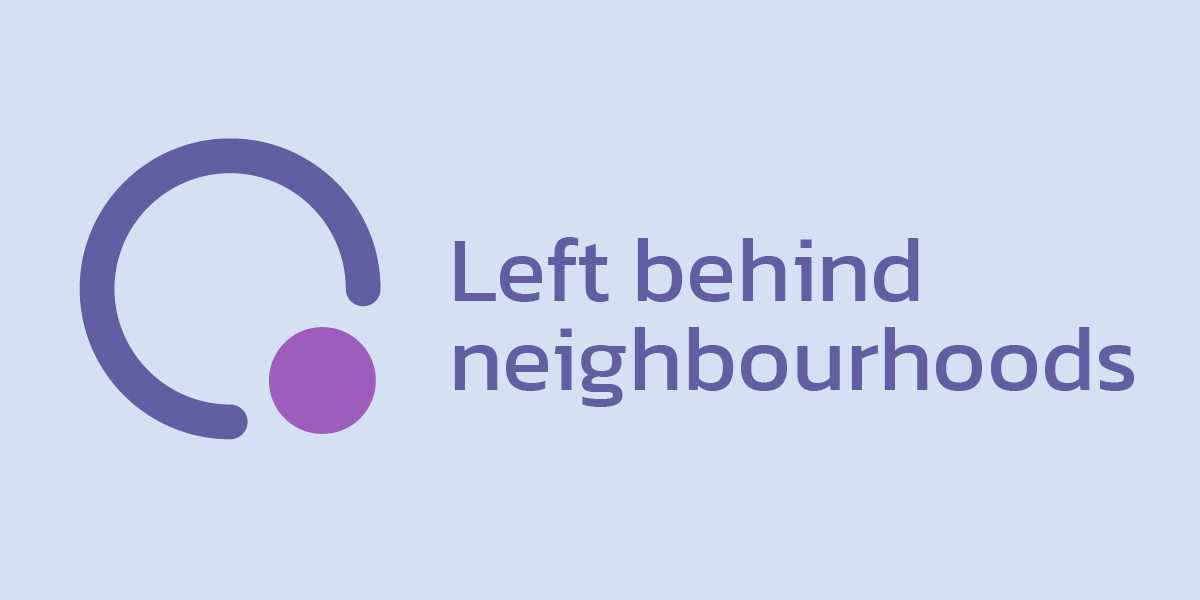
The All Party Parliamentary Group have published our Community data dive into ‘Left behind’ neighbourhoods. This report brings together a range of socio-economic data to provide an understanding of the strength of community in ‘left behind’ neighbourhoods (LBNs) in comparison to other deprived areas and England.
Compiling our report for the APPG we have been able to break it down into three distinct sections:
- Civic Assets: This section profiles LBNs and comparator areas in terms of civic and community assets and the density of these spaces across local neighbourhoods.
- The Third Sector: This section explores the strength of the third sector in LBNs with an overview of charitable organisations working in these areas, as well as funding streams for charitable work and the COVID-19 response in local communities.
- Community participation: This section explores levels of community participation in LBNs, looking at voter turnout at local elections, the predicted strength of local social relationships, participation in sport and leisure activities and the extent of volunteering, charitable giving, local action, community networks.
This new analysis explores community strength in terms of the availability of civic and cultural assets such as public halls, schools and leisure centres; the strength of the third sector via the work of charitable organisations and grant giving in local areas; and an overview of participation in the community with an exploration of voter turnout rates, civic participation, volunteering and the strength of local social relationships.
The report builds on our original research with Local Trust on ‘left-behind’ areas. This defines ‘left behind’ areas as those neighbourhoods with the 10% highest need and deprivation in both the Index of Multiple Deprivation and the Community Needs Index.
The key findings of the report for each section:
Civic Assets
LBNs have a lower density of community spaces, cultural, educational, leisure and green assets than other deprived areas and England:
- 72.9% of LBNs have less community space assets in their local neighbourhoods per person than the national average with the lowest density in Manor House in Hartlepool.
- 77.8% of LBNs have a lower density of educational assets than the England average – Sheppey East in Swale and Knottingley in Wakefield have the lowest density of educational assets of all LBNs.
- 77% of LBNs have less sport and leisure assets per person than nationally, with the lowest rates in Talavera in Northampton.
- Three LBNs record no green space assets in their local areas – these are in Bolton, North West Leicestershire and Middlesbrough.
- Four LBNs are amongst the areas with the lowest density of community or cultural assets on three or more of these measures: Breightmet (Bolton), Norton South (Halton), Sheppey East (Swale) and Yarmouth North (Great Yarmouth).
The Third Sector
- LBNs are less than half as likely to have a registered charity in their local area than the average across England as a whole. 97% of all LBNs have a lower rate of charities per 100,000 population than nationally.
- LBNs are also less likely to have other third sector organisations operating in their local areas including mutual societies, co-operative societies, community benefit societies and former industrial and provident societies groups. 92% of LBNs have a lower proportion of Mutual Societies registered locally than the national average – while 63 LBNs have no co-operative groups operating in their local area
- LBNs received fewer grants per 10,000 population than other deprived areas and England – though coastal LBNs (including Nelson in Great Yarmouth and Pier in Tendring) typically received the highest levels of grants funding per head.
- There were relatively fewer grants issued by charitable foundations in response to COVID-19 in LBNs than in other deprived areas and England, as well as fewer Mutual Aid groups set up specifically in response to the pandemic.
Community Participation in ‘Left behind’ neighbourhoods
- LBNs perform less well than the England average on measures of social connectivity, though broadly in line with the average across other deprived areas.
- However, LBNs perform particularly poorly on measures exploring the extent of civic engagement and participation – with lower levels across all identified measures than the average in other deprived areas and England as a whole – 97% of LBNs have lower levels of civic engagement than the national average and 98% have lower rates of volunteering.
- Voter turnout is lower than the national average in 92% of LBNs, with the six LBNs with the lowest levels of voter turnout all found in Kingston upon Hull.
- LBNs have a lower predicted strength of local social relationships than nationally, with 70.2% of all LBNs with lower scores on this measure than the average across England as a whole.
- Adults in LBNs are less likely to be physically active than those in other deprived areas or nationally – with 97.2% of LBNs seeing a lower proportion of adults engaging in 150 minutes of moderate intensity equivalent (MIE) physical activity than the national average.
Read the full analysis at ‘Left behind’ Neighbourhoods: Community data dive and see ‘Left behind? Understanding communities on the edge’ for the original piece of research into ‘left behind’ areas.
Find out more about our research services.
Featured posts

Case studies
A new need for deeper place-based insight When Arts Council England launched…
More
